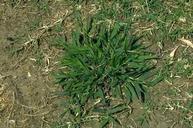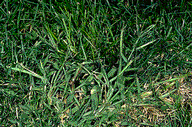Crabgrass is a nuisance! It is a group of weedy grasses in North America - Digitaria sanguinatis (large or hairy crabgrass) and Digitaria ischaemum (small or smooth crabgrass). It likes lawns that are under watered, under fertilized and badly drained or in other words, a “neglected lawn”. Even a well-cared-for lawn will have an occasional visit especially during difficult weather conditions and drought.
Crabgrass was introduced into the United States in 1849 by the U.S. Patent Office as a potential forage crop. It is good in dry and hot areas for summer forage, but we don't want it in our lawns.
 |
| Smooth crabgrass |
 |
| Large crabgrass in a lawn |
 |
| Smooth crabgrass seedling |
As an annual, crabgrass germinates, sets seed, and dies within one year. There is no need for fall expenses to get rid of it. Winter will do it for you.
Even when you mow it closely, crabgrass can still seed and will hurt your lawns vitality. A single plant can produce 150,000 seeds and the can remain viable for three years in the soil.
DO NOT LET IT GO TO SEED.
 |
| Flowering stem of smooth crabgrass |
There is no biological control to get rid of crabgrass other than livestock, however there are complete treatments you can buy and apply to get rid of crabgrass:
- Preventive treatments
- Organic sprays and treatments
- Selective chemical herbicides
- Non-selective herbicides
Or you can establish practices for maintaining a healthy lawn that naturally discourage crabgrass from thriving:
1) Planting the right turf grass species (shade, traffic, sun).
2) Watering correctly (full coverage and depth for good rooting for your variety of grass).
3) Proper fertilization (periodic application during growing season for your grass variety).
4) Regular dethatching and/or core aeration every couple of years.
5) Mowing the proper height for your grass variety and season.
How about here in the Treasure Valley?
For problem lawns in the Treasure Valley, start with applying per-emergent when temperatures in soil reach 50-55 degrees F for at least 4-5 straight days mid-March/April. Mow proper lawn height for your grass. Apply per label instructions, water in and have no rain for 24 hours. Use a broom and not a blower to remove from concrete. You especially want crabgrass protection between the grass and concrete. Wait a least two days to mow after application to keep from lifting any residue. Apply again in 3 months / 90 days.
For small infections, crabgrass can be removed by hand, the younger the easier. Water area and pull at base of plant gently to remove. Do not put weeds in your compost pile.
For bigger problems, check the following website or your local cooperative extension office for help.
 Inspection areas:
Inspection areas: Check the spark plug - Always ensure that the spark plug is clean and gapped correctly.
Check the spark plug - Always ensure that the spark plug is clean and gapped correctly.